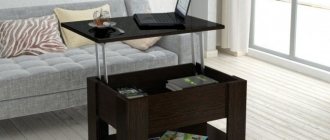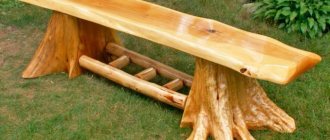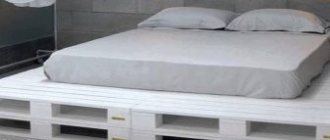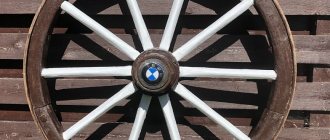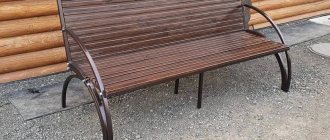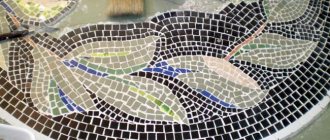When it’s time to care for the seedlings, many summer residents will breathe a sigh of relief, because they have this super helper!
We are talking about a small bench , which is so convenient for weeding and loosening, in a word, “gardening.” The advantages of such an assistant are obvious - size and mobility. It will save your legs and back, since you won’t have to squat for hours, hunched over too much!
Rather, scroll through our selection on just this topic and buy benches for weeding on AliExpress.
Subscribe to the channel now!
Types of chairs for weeding beds
There are several types of gardening tools that help you sow seeds, weed beds, and harvest ripe crops without much difficulty:
A chair on wheels for weeding beds. This unique device is equipped with a stable platform and pneumatic wheels. The seat can be rotated in different directions and adjusted in height. The distance between the wheels is 34 cm, which is quite enough for placement between the beds. The set may also include a hanging tray in which you can place garden supplies and ripe fruits. The permissible load on a chair with wheels is 90 kg.
Upside-down bench for weeding beds. This type of gardening device is a kind of transformer; it can be folded and unfolded. If necessary, the bench can be used as a knee rest. This allows you to reduce the load when performing various types of work on the site. The inverted bench is characterized by its relatively light weight (2.3 kg), ease of use, versatility, and does not cause difficulties during transportation. Thanks to the latches, the folding design holds the seat securely, giving you confidence when using it. Steel and polyurethane are used to make a knee-rest garden chair used for work in the garden.
Homemade bench. The design is distinguished by its simplicity and ease of manufacture. It can be easily carried and allows you to carry out almost all work on the farm, from laying seed in the ground to harvesting ripe crops.
Design advantages
The design of such a bench is quite simple. The two supports on the sides are solid, stable legs that will not sink even into wet or loose soil. And the inverted bench turns into a comfortable soft knee rest or hand rest for working in the garden.
The product, designed to perform numerous manipulations with the soil in the country or in the garden, is surprisingly multifunctional. On it you can:
- sit and relax during a break between digging up beds;
- perform work accessible from a sitting position, sitting comfortably on a soft seat, reducing the load on the legs and back;
- turning it over, kneel on it if a painstaking task requires bending over the bed;
- rest your hands securely on the high side posts, then it will be immeasurably easier to rise from your knees if your legs are numb.
A DIY upside-down garden bench will become a reliable assistant when performing many activities. With its help, any work in the garden is greatly simplified, including:
- cleaning tree bark, filling cracks, whitewashing trunks and lower skeletal branches;
- weeding beds, picking up seedlings, planting plants in the ground, loosening, trimming strawberry tendrils;
- landscaping the territory, painting borders, low picket fences, caring for flowers in the flower bed;
- picking berries from bushes, sanitary pruning of low bushes, tying cucumbers and other climbing plants, pinching.
Simplicity of execution and wide scope of use determine the increasingly growing popularity of the chair for working in the garden. An inverted bench makes it much easier to carry out daily care of plants and the territory.
Product dimensions
Having decided to make a bench with your own hands, you need to decide what dimensions are needed. A standard bench for a summer residence, without individual modifications, has the following dimensions:
- length – 60 cm;
- width – 30 cm;
- height of legs – 50 cm.
When creating an inverted garden bench with your own hands, you can approach the process creatively, changing the standard sizes according to your individual needs. For example, make the legs higher if the owner is tall and would find it uncomfortable to sit on a low chair. You can also lengthen or widen the seat, depending on the size of the person who will use the product, or for greater comfort. If the structure is assembled with your own hands from hollow tubes, then the main weight of the bench for working in the beds falls on the seat. In this case, it is quite possible to increase its size without significant weighting. Even if you add another 30 cm to the standard dimensions, the weight will remain virtually unchanged. If the garden inverted chair is made of wood or chipboard, any significant increase in size can affect the overall weight of the structure, which will make it inconvenient to carry and too bulky.
When determining the dimensions of a structure to create with your own hands, gardeners should consider what material it will be made from.
Drawings and dimensions of a garden invertible bench
Below is a sketch with the dimensions of the main parts of a garden chair used for weeding beds, planting seedlings, and any other work in which you have to work in a semi-squat, and sometimes squatting.
The structure is assembled from wooden beams and 35x35 mm slats. Particular attention is paid to the height of the seat at ground level. It will have to be selected individually according to your own height and arm length. A height of 45-50 cm is usually recommended; in an inverted position, the seat should be above the ground level at a height of at least 150 mm.
It is possible to make a bench - a pervert from thick plywood or boards according to the project given below. The design differs favorably from the previous version in that in the inverted position of the bench it becomes possible to use the sides as supports for the hands. In addition, the cutout in the seat allows you to easily carry the structure with one hand.
When making an inverted bench from boards or plywood, you need to pay attention to the connection of the seat with the sidewalls. Usually it is proposed to make the connection using the furniture method using wooden dowels. For an ordinary chair, perhaps this method would be suitable, but for a bench used for working in the beds, it is unacceptable. It is known from practice that wooden inserts quickly break and fail, so the connection of the seat with the sidewalls must be done using a metal corner.
How to make a bench for weeding beds with your own hands
To make a garden bench for weeding beds with your own hands, lumber left over from the construction of a fence, outbuildings, or home is most often used. This way the design is both affordable and functional.
The materials and tools for making a bench for gardening will require the following:
- boards 40 cm wide;
- drill;
- jigsaw;
- fasteners for wood (screws);
- furniture dowels.
The algorithm of actions for the manufacture of a wooden structure for weeding beds provides the following sequence:
- Make blanks for the legs and seat from existing boards. The height of the legs should be 55 cm, where the base is 38 cm and 24 cm. The shape of the legs is trapezoidal. In the wide part of the future leg you need to make holes for the handles. The size and shape can be absolutely any.
- To make a seat from consumable material, it is necessary to cut a rectangular blank with sides of 24 and 50 cm. To make it more convenient to carry the bench, a corresponding hole should be made in the canvas, which will serve as a handle.
- The bench is assembled by drilling recesses in the places where the seat and legs are fixed. Furniture dowels are used for installation. For better adhesion, it is recommended to use furniture glue. Additionally, the connection points must be strengthened using self-tapping screws.
- The finished bench for weeding beds should be painted or varnished. To create comfort when using it, you can attach some kind of cushions to both sides of the seat, for example, strips of polyurethane are suitable.
In addition to using the bench at the dacha, you can safely take it on vacation or fishing.
Lightweight folding bench for all occasions (2 sizes)
Price: from 787.77 rub. (check price and discount)
Seller's reliability: excellent!
Delivery within Russia: free!
Very convenient design. It arrived very quickly. The chair itself arrived intact. Folds out easily. Doesn't creak. It's stable on the ground.
Zheka
I waited 2 weeks for the parcel, to the city of Samara. It was packaged conscientiously. Dimensions as in the description. The chair is strong and can withstand more than 100 kg.
Blackbrand
I bought it in advance for the dacha. Everything is as in the description. I'm already looking forward to the weeding season)))).
Valya
View on AliExpress:
Materials and tools
Without a doubt, every summer resident, home craftsman or simply zealous owner will have in stock cuttings of boards, thick plywood or the remains of polypropylene pipes. It is quite easy to find raw materials from which you can make a garden bench for weeding in the dacha farm, in exactly the proportions that are needed. Examples of materials that gardeners can use to make a bench with their own hands, the features of their influence on the final weight of the product, the pros and cons are presented in the table.
| pros | |||
| Wooden boards | Affordable, durable, and with proper care will last a long time | Wood is afraid of dampness and moisture, so there is a risk of swelling and rotting if used and stored improperly | Depends on the type of wood and the degree of dryness. Well-dried pine or linden boards are light, the wood is quite soft |
| Chipboard, plywood | No special skills required, just the simplest tool needed | Materials pick up moisture very quickly and swell. The plywood begins to delaminate, and the chipboard begins to crumble. Less durable than other options, capable of deformation from gravity | The heaviest materials that can be used to make a standard size high chair |
| Hollow polypropylene tubes | Easy to process, as a rule, trimmings remain from repairs or construction and do not require special conditions for operation | A plumbing soldering iron is required | The lightest material possible. You can create a bench of any size that is convenient, it will have little effect on the weight |
A universal garden bench is easy to make with your own hands, you just need to put in a little effort. In addition to the necessary raw materials, you will also need tools. Basically, you take what is at hand: a hand saw or a grinder, a jigsaw, a drill for drilling holes. To work with plastic tubes, you will need a hacksaw for metal, as well as a plumbing soldering iron.
When working with tools, you must protect your hands with gloves and your eyes with goggles to avoid injury.
Wooden boards
Plywood
Chipboard
Polypropylene pipes
Required Tools
Additional equipment
The hard surface of the bench is uncomfortable for use, so this chair is complemented with a cushioned seat for the convenience of weeding beds. Since a soft pillow constantly gets dirty, it is more advisable to sew a soft lining in a removable cover. This option allows you to wash dirty fabric if necessary. A great example of such a product is a pillow with ties.
Master classes on making simple benches for the garden with your own hands
There are several basic requirements for fabric:
- it must be resistant to fading;
- synthetics are unpleasant to the skin, so textiles (with an optimal combination of synthetics and natural threads) are preferable;
- the material must be sufficiently soft and at the same time dense.
Such a bench is used in the garden, which involves direct and constant contact with the ground. In this regard, in order for the accessory to last a long time, you need to choose the right fabric for it.
Materials that are suitable as filler:
- padding polyester;
- foam;
- holofiber;
- struttofiber;
- tourist foam;
- other synthetic padding materials.
The best solution is to attach a soft, removable cushion to the bench on both sides: this will make it more convenient to work in the garden and more comfortable to sit. Of course, the size of the gardener's bench must be taken into account. Additionally, you can attach fabric pockets on the sides to store small items or, for example, water bottles. Some people sew on a shoulder strap, allowing you to free your hands when carrying furniture.
A zippered cover would also be a good option to make washing easier. To prevent the filler from getting lost, it is worth sewing the product with squares. Embellishments, embroidery, frills and appliqués are usually not used.
The process of creating a do-it-yourself pillow for a universal garden bench is quite simple:
- It is necessary to measure the parameters of the furniture to determine the dimensions of the future product.
- Prepare the filler. The thickness of the foam rubber (or other material) should be approximately 2 cm.
- Create a pattern (this is not difficult, because you need a simple geometric shape).
- If you want to add softness on both sides, you will need two pillows.
- Cut out the desired size, lay it wrong side up, and sew three seams on a sewing machine. To make the seam even, first make a basting using a needle and thread.
- If you need to insert a zipper, it is sewn in immediately.
A DIY folding bench is suitable for weeding beds, harvesting crops and other garden work. The product is lightweight - you can turn it over at any time to sit down and relax. You can also create a folding structure - it will take up very little space.
Knee pads
Probably the simplest and most budget option. They protect joints from cold, dampness and injury, making work more comfortable. The main thing is to choose a comfortable model so that it fits your feet, as they say. I haven't been able to find one yet, unfortunately. Although I think I would use the idea from the following short video...
A pocket for a knee pad on work trousers easily and elegantly solves the problem that for me personally has become the main obstacle to using these devices - the way they are attached: the straps put pressure on the leg, causing considerable discomfort and causing swelling.
If you fix it too loosely, the structure simply slides. However, I know summer residents who found the purchased knee pads to be just right and really liked them. By the way, among the seven-dacha residents there are also such: Super knee pads from Seedspost.ru. Perhaps, over time, I will find “my” option... A wide range of knee pads of various models for gardening and construction work is presented in our catalog, which combines offers from large gardening online stores. View a selection of knee pads and choose the ones that suit you .
Why do you need a chair for weeding beds?
The presence of a folding chair for garden beds allows you to:
- protect knees and joints from excessive stress, injuries, and various types of damage;
- make harvesting more comfortable;
- facilitate the process of processing beds;
- Do not unnecessarily compact the soil in the weeding area;
- do not injure vegetable and berry crops during weeding and loosening the soil.
The market offers a huge range of universal benches for weeding beds, which allows every gardener to choose the most suitable option for himself. As for the material, a bench for working in garden beds can be made of wood, plastic, or metal.
Important! Before purchasing a bench for working in the garden, you need to study the operating instructions. You especially need to pay attention to the permissible weight that a particular model can withstand.
Vertical bed
Vertical beds made from bicycle wheels.
Original vertical beds, which can be made from unnecessary bicycle wheels and strong rope, are perfect for growing climbing plants, will help save space and will become an unusual detail in the garden.
Sources used:
- https://mblx.ru/lavka/1303-universalnaa-skamejka-dla-ogoroda-svoimi-rukami.html
- https://b-online.ru/malye-formy/skameechka-dlya-raboty-na-gryadkah-chudo-izobretenie-dlya-komfortnoy-propolki.html
- https://7dach.ru/marinagerasimenko/legkaya-propolka-nakolenniki-kovriki-stulchiki-i-drugie-dachnue-pomoshniki-224353.html
- https://novate.ru/blogs/150517/41338/
